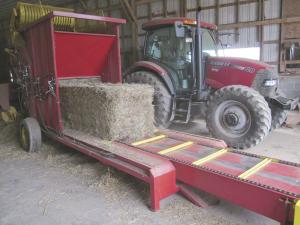2013 - Volume #37, Issue #3, Page #09
[ Sample Stories From This Issue | List of All Stories In This Issue | Print this story
| Read this issue]
Bale "Destroyer" Rips Apart Big Squares For Re-Baling
 |
The Bale Destroyer feeds any size large square bales across a metal hay chute and into a compartment with a large rotating reel. The reel is built like a conventional hay pickup with 196 steel tines. Those tines loosen and tear apart slabs as the bale moves into the machine. A second reel on top of the compartment fluffs the hay to separate any small chunks. That reel deposits a stream of loose hay onto a small conveyor at the back of the machine, which flows into a conventional small square baler parked behind the Bale Destroyer. Small squares are pushed out the back of the baler and packed by hand or tossed into a bulk rack with a bale thrower.
Haldeman says the Bale Destroyer is powered by hydraulics from the tractor that’s running the pto-operated small square baler. The Destroyer has three hydraulic motors that require 10 gpm oil flow. “It uses hydraulic motors with variable flow control so the drums and conveyors have adjustable speed control,” Haldeman says. “Different size bales and different products, whether hay or straw, feed in at different speeds. The important thing is to have consistent flow and consistent speed.” Haldeman says the Destroyer will rip apart a 3 by 4 by 8-ft. big square bale in about 3 min., which produces about 20 to 25 small squares. “One man can place the big bales and remove the twine while another man moves the small squares away,” Haldeman says. “It has the capacity to handle 15 or more big bales per hour.”
Bale Destroyers are custom built one-at-a time in a local blacksmith shop. The frames are made of sturdy tube steel with 1/4 in. sheet steel used on the sides of the hay compartment. The conveyor platform, which is 20 ft. long and 3 ft. wide, has an apron chain that moves bales into the Destroyer. The platform raises with hydraulic power and folds tight to the machine for transport. A hitch tongue can be inserted into a receiver under the machine so a tractor or pickup can move the Destroyer.
Haldeman says the machine was designed by employees of the business who “sat down and just sort of came up with the plans”. They had previously built a small bale destroyer to take apart mini-bales, so this was a much larger version of that design. They have built and sold 14 of the Destroyers. “They build them all by hand, one at a time, so there’s personal attention at every step,” Haldeman says. It takes about 100 to 150 hrs. to build a machine. The completed Destroyers weigh about 4,600 lbs., are 16 ft. long, 7 ft. wide and 11 ft. 6 in. high when the feeding table is folded for transport. The machine sells through two dealers for $18,900, plus shipping.
Haldeman thinks the machine has a unique spot in the ag market. He has sold Bale Destroyers in New Jersey, Pennsylvania, Canada and Colorado. The fellow from Colorado drove to Elizabethtown and towed his machine 1,400 miles back home, complete with torsion bars and shock absorbers that were built especially for the trip. Haldeman says the New Jersey customer plans on buying big squares at hay auctions and re-baling them into small squares for people who sometimes pay from $5 to $10 for a single small bale. “In the process he should be able to make $150 to $200 a ton, and maybe more if people are buying just a bale or two at a time,” Haldeman says.
Contact: FARM SHOW Followup, Curt Haldeman, Messick’s Farm Equipment, 187 Merts Dr., Elizabethtown, Penn. 17022 (ph 800 222-3373; curth@messicks.com).

Click here to download page story appeared in.

Click here to read entire issue
To read the rest of this story, download this issue below or click here to register with your account number.




